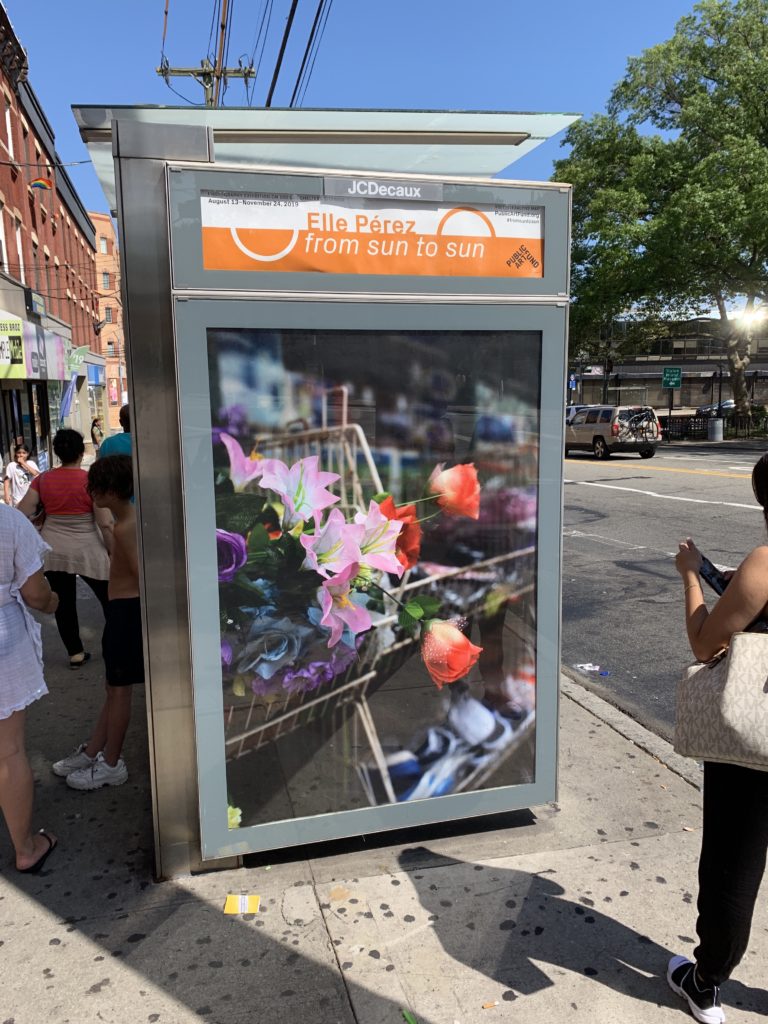[ad_1]
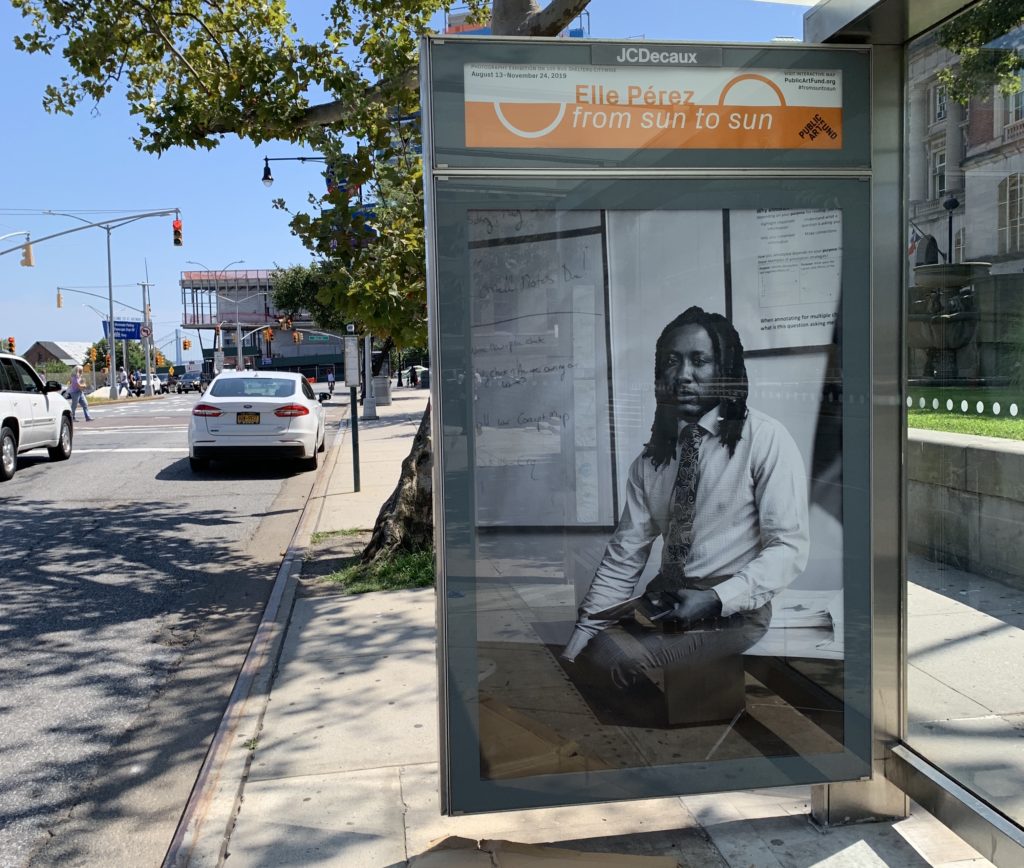
Elle Pérez’s Brandon T., Activist Educator (2019) in the St. George section of Staten Island.
PHOTOS: ANDREW RUSSETH/ARTNEWS, EXCEPT WHERE NOTED
“Art of the City” is a weekly column by Andrew Russeth that runs every Tuesday.
THIS WEEK… Elle Pérez dots New York with 100 tender photographs, Hadi Fallahpisheh makes a star turn at Tramps, and the glorious return of ART-RITE in reproduction.
Only Connect
A few months ago, I sliced off a tiny bit of my right index finger. I was talking on the phone and using a huge knife to chop cilantro (a fact mocked by my doctors and nurses, which is fair), and I ended up sporting a sizable bandage for quite some time. To avoid injuring the wound as it healed, I stopped biking and running, avoided crowded subways, and walked a lot—slowly. Elle Pérez’s current Public Art Fund project came along at just the right time. Titled “from sun to sun,” it has brought prints of 16 of the artist’s intimate photographs to bus shelters in all five of the city’s boroughs. It’s a project that rewards long strolls.
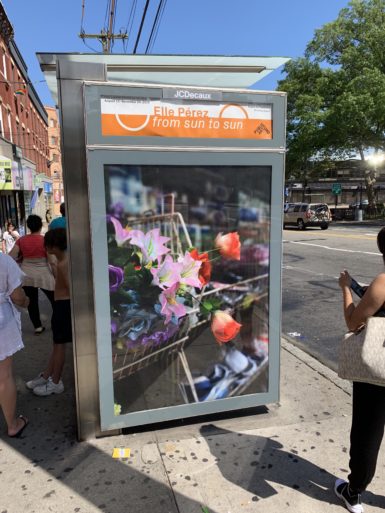
Elle Pérez’s Roses (2019) at a bus stop in the Tompkinsville section of Staten Island.
Just off the ferry in Staten Island, the black-and-white photo Brandon T., Activist Educator shows its namesake perched atop a desk, looking at the camera with a gentle gaze, iPad in hand. A few blocks away, in another work on view next to Tompkinsville Park, radiant silk roses—red-orange, baby blue—spill from metal baskets outside a shop. And on a quiet street in Sunnyside, Queens, yet another shot shows Puerto Rican flags waving serenely, seen from below in black and white. These pictures recur throughout the exhibition (which spans 100 advertising locations in more than a dozen neighborhoods), along with ones of a cracked sidewalk, a worn subway seat, a weathered door—places and things that have seen a lot and been touched by countless people.
Spotting Pérez’s works becomes a kind of treasure hunt, with the side benefit of awakening you to other sights, like a wonderfully named What U Need Deli & Grill or an orange peel crushed into a brilliant abstraction on the asphalt. They are located in areas that have been important to the Bronx-born artist, who is 30 this year. (An online map guides the way.) Walking to view Pérez’s latest works, one has the uncanny sense of seeing the city through another person’s eyes, finding where their map of New York just might overlap with your own. “I think I went to that bakery years ago,” I found myself thinking, blessedly forgetting the pain in my finger for a few minutes one morning. “And a woman I used to date lived here. Maybe.”
Hands appear repeatedly in these pictures: they’re caring for a garden, or digging into an absolutely sumptuous-looking bowl of arroz con pollo with plastic forks, or, in a series of majestic close-up shots, enacting the intricate steps of completing the Flight, a handshake from the Bronx punk scene. One could think of “from sun to sun” as an impressionistic memoir, or as a distillation of the little jolts of beauty this city delivers at unexpected moments, through exquisite fake flowers, a hearty meal, a beloved flag, or a greeting passed by code from one individual to another. (Organized by PAF’s assistant curator, Katerina Stathopoulou, the exhibition runs through November 24.)
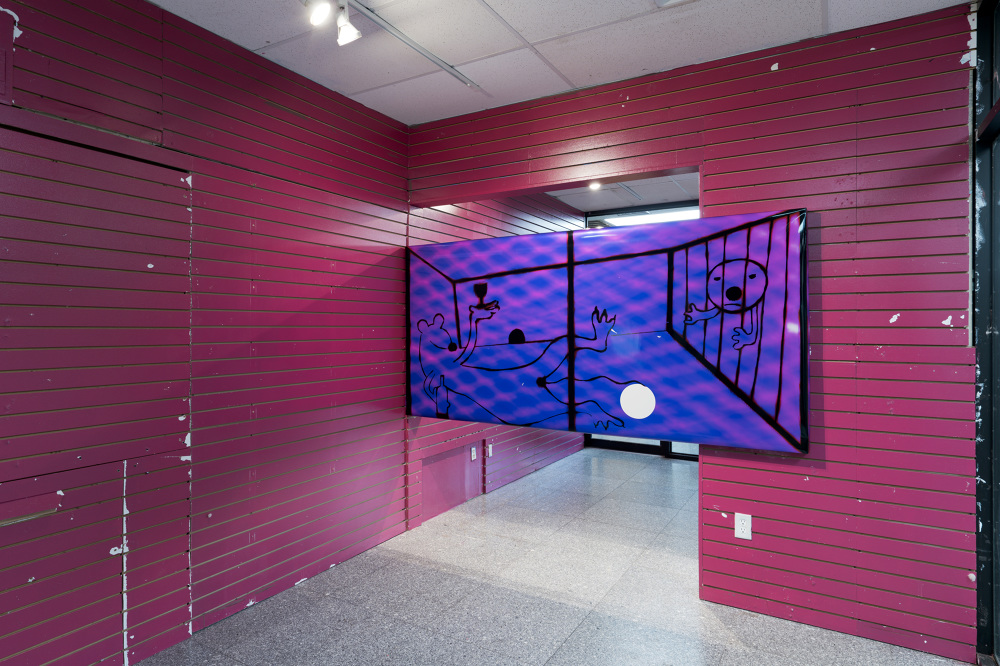
Installation view of “Hadi Fallahpisheh, Almost Alone” at Tramps, New York.
COURTESY TRAMPS
Spring a Trap
Hadi Fallahpisheh’s current outing at Tramps gallery is alluring, delirious, chancy, bizarre, comic, and even a little evil. (You can’t beat evil.) It is easily one of the best gallery shows of the year in New York. The most exciting works are line drawings (they’re unique photographs, technically), which Fallahpisheh makes atop vibrantly glowing grounds by means of darkroom alchemy. He ingeniously manipulates light, chemicals, and paper, and all of a sudden, a mouse with cool shades is standing behind bars, glowing burnt amber. In an electric blue piece, a blob-like human form crawls in a cage—or is it a crib?—toward a dark hole. Set in spare prisons and houses, they recall Bill Traylor drawings or slapstick cartoons. These are captivating visions of cat-and-mouse shenanigans, brutal psychological brinkmanship, and dream logic (or just a fertile mind) run amok.
There are white ceramic cats, too, with mischievous grins and dinner-plate-flat faces that suggest they are pressing up against the bottom of a glass table, plus simple constructions that are perhaps best described by quoting the checklist’s deadpan explanation: “All the pillow houses are stolen pillows filled with rice and dirt.” Fallahpisheh, who was born in Tehran and is now based in New York, turned 30 just two years ago. He’s overflowing with piquant, improbable ideas. His show runs through November 17. I can’t wait to see what he gets up to next.
Let’s Get Rite
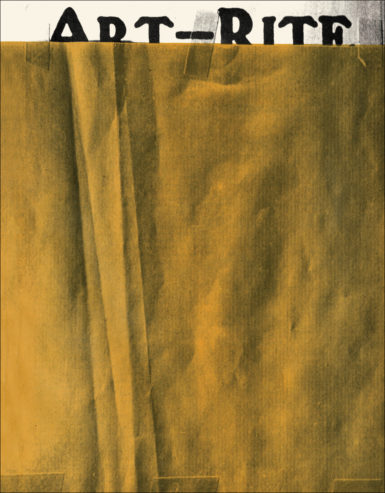
Art-Rite No. 5, Spring 1974, with a cover by Christo.
COURTESY PRIMARY INFORMATION/PRINTED MATTER
At a time when there is much fretting about the health of art criticism, it’s refreshing to come across Printed Matter and Primary Information’s exquisite new facsimile of Art-Rite, the charmingly scrappy outlet that ran in New York from 1973 to 1978, billing itself as an “unpredictable art magazine with nonformidable criticism in a disposable format.” It crackles with good ideas that are ripe for replication and adaptation, and it contains an irreverent tone that actually does exist today, though usually only spotted in scattered artists’ blogs, sardonic Instagram accounts, group chats, and the odd podcast.
Where to begin? No issue was ever quite like another, but a defining thread of the vision of editors Edit DeAk, Walter Robinson, and Joshua Cohn (who dropped out midway through its 20-issue run) was a commitment to the voices of artists and writers. “I enjoy giving books I have made to others,” John Baldessari says in one issue. “Art seems pure for a moment and disconnected from money.” Writes Les Levine, “What the audience expects from the artist is that you be some heroic figure, which they can look up to.” In a condensed interview, Julian Schnabel expounds on man’s best friend; an editorial note concedes, “We should say that he does talk about things other than dogs.”
One element remained constant: artists designed the covers, and Dorothea Rockburne crafted a heartbreaker by simply folding it diagonally to form a triangle below the logo.
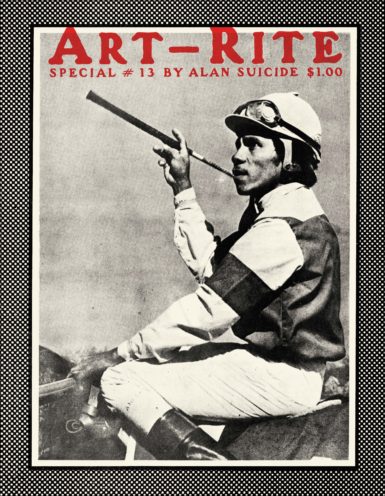
An all-visual issue of Art-Rite, No. 13, January 1977, guest-edited by Alan Suicide.
COURTESY PRIMARY INFORMATION AND PRINTED MATTER
Semi-recurring features included breezy reviews, artist projects, and substantial, unsigned profiles of art critics like Max Kozloff (“Maximum Kozloff” is its winning headline), Lucy Lippard, and Douglas Davis, who offers an opinion that could have been delivered this morning: “If you’re seriously involved in art I don’t see how you can be completely satisfied about any of the ways to earn a living it.”
Minutiae delight. Linda Nochlin shows up in the letters section of an early issue declaring Art-Rite “too cute for words,” while scolding the team for misspellings of Clement Greenberg and Claes Oldenburg. Nochlin, née Weinberg, writes: “Most Artb-rgs are bergs; most Jewishb-rgs are bergs; more other b-rgs are one or the other.”
The ads alone are worth spending time with: Castelli and Sonnabend marketing videotapes, Betty Parsons quoting herself (“Feeling is the content of art”), a one Norm Dolph offering “portable discotheque for loft parties” (“We can work it out” was his catchy slogan).
It all amounts to a portrait of an art world much smaller than today’s, and also one a bit more cloistered from mainstream culture. Artists and writers were experimenting, and a great deal of fun was taking place, the volume suggests, but the go-go 1980s were approaching. A lot was about to change.
RECENT COLUMNS… The new MoMA, public art and a Chase flagship branch in Midtown Manhattan, a guide to art museums and ice cream around New York.
Andrew Russeth is executive editor of ARTnews. He can be found on Twitter and Instagram, and reached at [email protected].
[ad_2]
Source link

